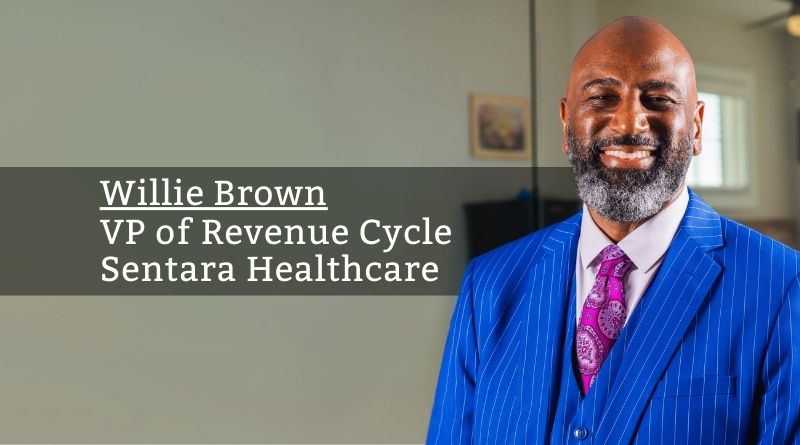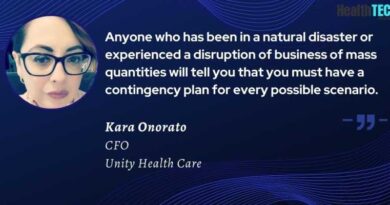Revenue Cycle: The Healthcare Delivery Experience Bookends
By Willie Brown, VP of Revenue Cycle, Sentara Healthcare
During a recent leadership meeting with our CFO, we were reminded that as quiet as it is kept, an organization’s revenue cycle acts as bookends for the healthcare delivery experience. In a broader context, a person or process representing a healthcare provider’s revenue cycle is often the first and/or last interaction that the healthcare provider has with a customer. The typical healthcare consumer cannot adequately articulate the functional importance of the revenue cycle. However, undoubtedly, it represents the first and final verse of a progression that should flow melodically and seamlessly. This melody can be, and is often easily disrupted, by the complexity involved with navigating and financing healthcare.
Vacillating between the clinical, financial and emotional aspects of the healthcare delivery process can be stressful for consumers and providers. However, healthcare providers understand this conundrum and are laser-focused on developing solutions for improving the Patient Financial Experience. As a revenue cycle leader for 30+ years, I have had the pleasure of seeing firsthand how a high-functioning revenue cycle can improve clinical and emotional outcomes from a holistic perspective. As such, we in the healthcare delivery industry, specific to the revenue cycle, must unapologetically and unabashedly pursue a “put people first” mentality.
A healthcare provider that does not invest in technology on par with other service-related businesses will struggle to sustain itself.
Train, Recognize, Reward and Repeat
I am an unwavering believer that happy team members result in happier customers. Leaders can make the mistake of focusing solely on the “client perception” and completely miss the need to invest in the individuals that drive the customer perspective. When customers present to healthcare providers with what can be life-altering events, I am not naïve to believe that the revenue cycle can make that experience less unnerving. However, I do believe in setting forth robust continual training, clear accountability metrics, along with thoughtful reward and recognition to revenue cycle team members.
Engaged and empowered team members will advocate for the customer and the provider in a symbiotic manner that will create synergy in a way that is impossible to replicate without their meaningful input.
Transparent Financial Assistance and Clearance Programs
When putting people first, an organization must continually review, update and share their financial clearance and assistance policies to meet the real time needs of the customers they serve. Ensuring that communities, advocates and team members understand that financial support programs exist is pivotal. Equally important to stakeholders is knowing that support programs exist and educating them on how to access and navigate these programs.
Being clear advocates for the customers they serve will help a healthcare provider be more in sync with the customer’s perception of care. Fair or not, we have all learned the hard way that “perception can be as strong as reality”. As healthcare providers, we should attempt to overshare how and why we support the patient’s financial journey with our team members and customers. Having this level of transparency is mandated in some ways, but clearly, customers have come to expect that healthcare providers will go above and beyond the letter of the law, whenever the opportunity exists to do so.
When healthcare providers do not consistently, proactively and deliberately debunk the notion that “they only care about making more money”, the provider does themselves and their customers a great disservice.
Use Technology as a Differentiator
Another way that healthcare providers can put people first in their efforts to support their team members and customers is through leveraging technology. Technology through an organization’s electronic medical record (EMR) can be a tremendous satisfier. A healthcare provider that does not invest in technology on par with other service-related businesses will struggle to sustain itself. A detrimental symptom of this type of stagnant mindset will be the leakage of talent to organizations and industries that are more receptive to technological enhancements. Some ways healthcare providers can and do utilize technology to improve the patient financial experience include:
- Self-Service Registration
- Self-Service Payment Options (Pre and Post Service)
- Self-Service Financial Assistance Application Filing
- Self-Service Cost of Care Estimates
- Self-Scheduling (for limited modalities)
- Billing Process Information on Provider’s Website
- Self-Service Payment Plan Initial Set-up and Update
I don’t need to lament the fact that healthcare finance is complicated, even for those of that are privileged to have chosen it for a career destination. The truth of the matter is that payment rules constantly change, it is challenging to recruit/retain talent in the revenue cycle space, and, yes, unfortunately, shrinking margins are a real thing. Nevertheless, I am totally optimistic that we as healthcare finance and revenue cycle connoisseurs, will adapt to the ever-changing climate. That is to say in no uncertain terms, we must adapt and continue to transform.
With what I’ve been able to share, I’ll end with this thought: “Our customers depend on healthcare providers, rightfully so I must say, to understand the landscape we operate in. We are, I strongly believe, well positioned, like never before, to lead our customers and cohorts through this most difficult of terrains.”
Making these and many more efforts like this a priority has shown that the financial realities do not necessarily have to add to the stress of the healthcare consumer. We can and should instead make things a little easier and provide the benefit of having one less thing to worry about for those we have the privilege to serve!



